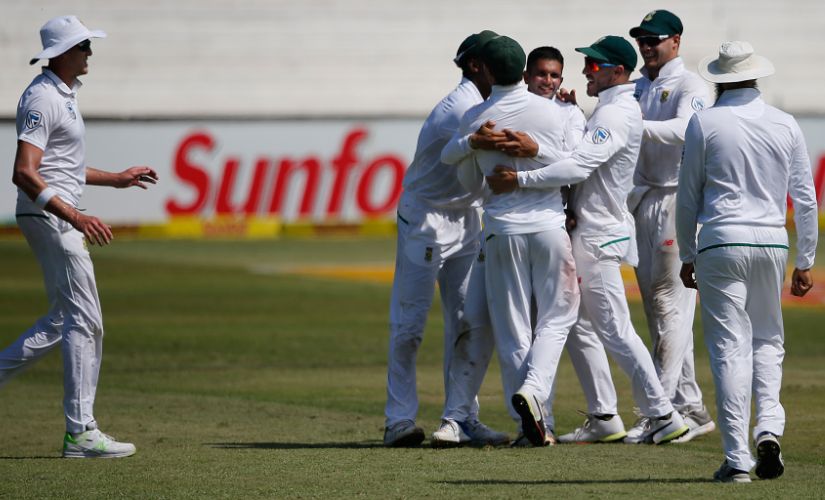“A spinner bowling 31 overs on Day 1 in South Africa is a joke in my opinion, groundsmen needs to be asked a lot of questions!,” Graeme Smith had tweeted after the opening day of the Centurion Test between India and South Africa in January. Ravichandran Ashwin was the bowler in discussion then but no such complaints could be heard, at least from the Proteas fan club, after Day 1 of the Durban Test against Australia on Thursday when Keshav Maharaj bowled 24 of the 76 overs — close to one-third of total overs — in the day’s play. Unlike Centurion, the Durban wicket was possibly made to to turn, given Australia’s most dominant, Bradman-like force, Steven Smith’s woes against left-arm spinners. The casual, flamboyant Steven Smith is one of the most complete Test batsmen going around in world cricket and is to Test cricket what Virat Kohli is to One-Day Internationals (ODIs) these days — an unstoppable run machine. Yet, if at all there is one minor chink in his batting, a frailty if it can be called, it is his tendency to falter against left-arm spinners. In his breathtaking 62-match Test career which has evoked comparisons to the greatest-ever batsman to wield the willow, Smith has been dismissed by left-arm spinners a stunning 19 times. While his career average stands at 63.67 — including 50+ scores in each of the 20 Test series that he has been a part of — it drops to 38.52 against left-arm spinners. This is in sharp contrast to his averages against every other kind of bowler. It is perhaps also the reason why he hasn’t been his overwhelming self against Bangladesh, who boast of a slew of left-arm spinners in Tests (he averages 29.75 in four innings against Bangladesh). Rangana Herath (five times in three Tests), Ravindra Jadeja (four times in six Tests), Taijul Islam (twice in two Tests) and even Dean Elgar (once) have had success against him. Keshav Maharaj, the unassuming, underrated Protea spinner had dismissed Steven Smith at Perth on his debut in November, 2016, and came into the attack as early as the 11th over on Thursday. The left-arm spinner had just bowled a total of 36 overs the entire Indian series, but on a pitch possibly tailor-made to exploit Smith’s weakness against left-arm spin, Maharaj sent down 24 overs on Day 1. [caption id=“attachment_4373261” align=“alignnone” width=“825”] South Africa’s Keshav Maharaj celebrates the dismissal of Australian captain Steven Smith in Durban. AFP[/caption] Early signs were, however, different as Smith looked composed and resolute against the South African spinner. He danced down the track like a ballerina to counter Maharaj’s extravagant turn and whipped him through mid-wicket many a times. After quite a few of them, it seemed like Proteas had switched tactics to Smith, for Morne Morkel steamed in with a leg-slip in place and bowled short to the Aussie, looking to catch him off-guard on his acclaimed shuffle. This tactic is often used against Smith but has mostly been futile courtesy his impeccable hand-eye coordination. Smith is murderous on the leg-side and anything short or off target is pulled or whipped with disdain in front or behind square. This is evident from his career strike rates through the leg-side (117.57 through square leg, 98.18 through mid-wicket and 83.06 through mid-on). In this match (as the CricViz tweet shows), courtesy South Africa’s bizarre ploy to bowl short and straight to him, Smith pounded runs through the leg-side even more freely (scoring-rates being 250 through square leg, 123.07 through mid-wicket and 110 through mid-on).
Add to it the fact that he averages a mind-boggling 124.33 against right-arm pace bowlers since the beginning of 2016, and you wonder if South Africa had really done their homework. They tried everything from unorthodox field placements — they had a leg-slip and a short gully at one point of time — to switching the line of the attack, but found no respite as the Australian smashed yet another half-century. Interestingly, since 2016, the Australian’s average falls to 23.25 against left-arm orthodox spin, and it is probably this that prompted Protea skipper Faf du Plessis to go back to his strike spinner on an un-South African wicket. Maharaj and the unerring Vernon Philander tied down Steven Smith for a while with persistent channels of attack and his scoring rate took a dip. He scored just 10 runs in 51 balls before Keshav Maharaj got Smith to edge a cut to the keeper. The ball ricocheted off Quinton de Kock’s gloves and was safely pouched at first slip. For most batsmen scoring 56 means a boost in average, but for Smith, it brings down his average, another telling fact of the sheer class of the Australian skipper. Faf du Plessis and Co had tried everything in their arsenal to counter Smith, but in vain, until they decided to back the statistics and threw Maharaj at Smith. Early signs point to yet another run fest from Steven Smith this series but just for once, a team might have really opened up a chink in the Australian’s armour. Keshav Maharaj is extraordinarily consistent with his lines and has shown enough confidence to back his plans even in times of strife in his short, but exciting, Test career thus far. If he can get it right against Steven Smith, Australia would have a lot more to worry about than just fronting up to Kagiso Rabada.


)

)
)
)
)
)
)
)
)



